Recent Mold Remediation Posts
SERVPRO of Memorial West, NW Houston: Your Trusted Team for Mold Removal
10/21/2024 (Permalink)
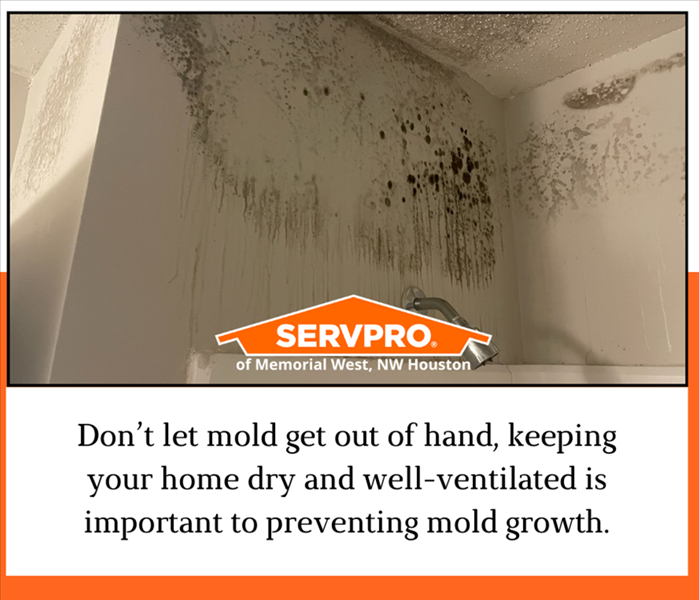 Don't let mold get out of hand! SERVPRO is your trusted leader in mold removal in Houston.
Don't let mold get out of hand! SERVPRO is your trusted leader in mold removal in Houston.
SERVPRO of Memorial West, NW Houston: Your Trusted Team for Mold Removal
Who do you turn to as a trusted company for mold removal? Finding the right company to help can feel overwhelming, but SERVPRO®, the nation's leader in mold removal, is here for you. SERVPRO of Memorial West, NW Houston is here to help with quick, professional mold removal and remediation services.
If you are worried about mold in your Houston home, bathroom, or crawl space, don't feel stressed out. SERVPRO can help. Our team has the skills to keep your property safe and clean. The EPA offers mold clean up suggestions for small areas, but its larger then 10 inches by 10 inches, here’s how we can help you:
Bathroom Mold Removal Near You
Bathrooms are a common spot for mold growth because of the moisture from showers and sinks. If you notice mold spores in your bathroom, let us take care of it with our bathroom mold removal service. Our teams will treat, sanitize and repair the infected areas.
Black Mold Remediation for Your Health
Black mold can be harmful to your health, especially if it spreads inside your home. Our team offers black mold remediation to quickly and safely remove toxic mold. Our teams have the training, experience and advance technology to make sure your home is safe, so you don’t have to worry about the risks that come with black mold.
Crawl Space Mold Removal Experts
Mold can also grow in your crawl space, where you might not notice it right away. If mold spreads there, it can impact the air quality in your whole house. Our crawl space mold removal service targets these hard-to-reach areas and removes mold before it causes bigger problems.
Why Choose SERVPRO of Memorial West, NW Houston?
We are the best mold removal companies in Houston. We have the experience and equipment to handle all types of mold and water damage. Our team is certified following IICRC requirements to use the latest tools and techniques to clean up mold and stop it from coming back.
SERVPRO of Memorial West, NW Houston: Your Go-To Team for Mold Removal Services
Dealing with mold in your home or business? SERVPRO of Memorial West, NW Houston is here to provide fast, professional mold removal. Whether it's in your bathroom, crawl space, or any other part of your property, we’re ready to help. Here's our comprehensive mold remediation process to keep your space mold-free and safe.
1. Identify and Remove
We begin by identifying all mold-affected areas and creating a detailed plan to safely remove the mold. We contain the contaminated areas, establish negative air pressure, and use HEPA filters to avoid cross-contamination. If any furniture or personal items are affected, we’ll carefully inventory and pack them for off-site cleaning and decontamination.
2. Humidity Control
Mold thrives in damp, dark spaces, so controlling humidity is crucial. We create a custom drying plan to safely reduce moisture to safe levels. Using dehumidifiers and air movers, our technicians ensure your home reaches its target Equilibrium Moisture Content (EMC), stopping further mold growth.
3. Clean-Up
Once the area is dry, we use HEPA vacuums on all surfaces to eliminate tiny particulates. If needed, we’ll clean and sanitize air ducts, using disinfectants and anti-microbial products to remove any chance of residual mold. A final vacuuming ensures a complete clean-up.
4. Put Back
After mold removal and clean-up, we restore your space to preloss condition. We’ll reinstall flooring, repaint, and put back your furniture to make your home or business look like new.
Don’t let mold take over your property! Contact SERVPRO of Memorial West, NW Houston today for the best mold removal services near you. We're just a call away to help restore your space safely and professionally.
Call SERVPRO of Memorial West, NW Houston Today!
If you’re dealing with mold or water damage, don’t wait! Call SERVPRO of Memorial West, NW Houston today for fast and reliable service. We’re here 24/7 to help with your mold removal and mold remediation needs.
Big or small, our team of experts is trained to handle any situation. We use advanced techniques and equipment to ensure that every trace of mold is removed and that your property is safe for you and your loved ones. With our thorough inspection process, we identify the source of the moisture that caused the mold growth, so we can prevent it from returning.
At SERVPRO of Memorial West, NW Houston, we understand how stressful dealing with mold can be. That’s why we strive to make the restoration process as smooth as possible. From the moment you contact us, we’ll guide you through each step, keeping you informed and reassured.
Don’t let mold compromise your the integrity of your property. Our dedicated team is ready to respond quickly and effectively. Reach out to us today, and let us help you reclaim your space. Your satisfaction is our priority, and we’re committed to providing you with the highest quality service. Call SERVPRO of Memorial West, NW Houston now!
The Importance of Professional Mold Removal: Why DIY Isn’t Enough in Houston
8/30/2024 (Permalink)
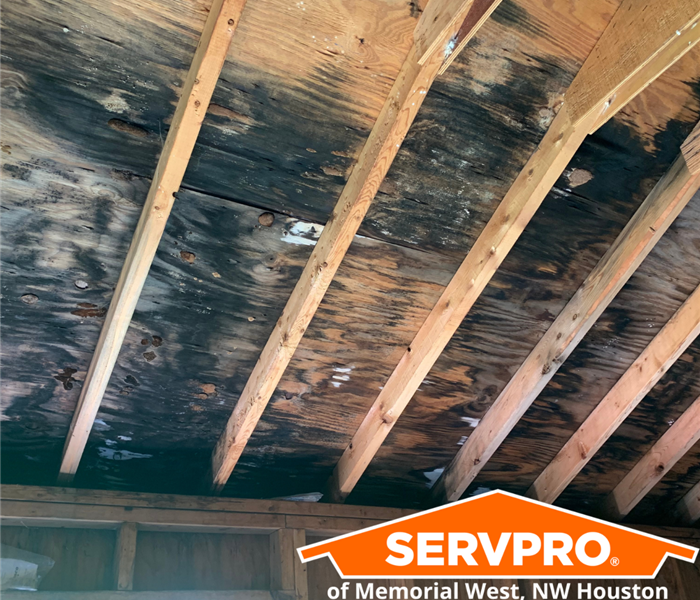 Mold Remediation in Houston, TX
Mold Remediation in Houston, TX
When faced with mold issues, it’s tempting to consider a DIY approach. After all, it might seem straightforward—scrub the affected areas, spray some cleaner, and call it a day. However, at SERVPRO of Memorial West, NW Houston, we know that mold removal is far more complex than it appears. In Houston's humid climate, where mold growth can be particularly aggressive, professional mold removal is not just a luxury; it's a necessity. In this blog, we'll explore why DIY methods fall short and why professional intervention is essential for effective mold remediation.
The Limitations of DIY Mold Removal
1. Incomplete Mold Removal
DIY mold removal often only addresses the surface mold you can see. However, mold can grow behind walls, under floors, and in other hidden areas. Without professional-grade equipment and expertise, it’s easy to miss these hidden infestations, allowing mold to continue growing and spreading.
2. Risk of Mold Recurrence
Improper mold removal can lead to recurring mold problems. Without addressing the underlying moisture issue or ensuring thorough removal, mold can reappear, sometimes even more aggressively. Professionals use advanced techniques to not only remove existing mold but also to address the root causes to prevent future growth.
3. Health Risks
Handling mold without proper protective equipment can expose you to health risks. Mold spores can become airborne during removal, potentially causing health problems. Professionals are trained in safe mold removal practices and use protective gear to minimize these risks.
4. Structural Damage
Inadequate DIY methods can cause further damage to your home. For example, using incorrect cleaning solutions or techniques might damage building materials, leading to more significant repairs. Professional mold remediation includes careful handling of materials and restoration to ensure the structural integrity of your home is maintained.
Why Professional Mold Removal is Essential
1. Comprehensive Inspection
Professionals conduct thorough inspections using advanced tools to detect hidden mold and moisture. This helps in identifying the extent of the problem and developing a targeted remediation plan. Techniques like thermal imaging and moisture meters are crucial for uncovering mold in concealed areas.
2. Effective Remediation
Professional mold removal involves more than just cleaning visible mold. It includes:
- Containment: To prevent mold spores from spreading to unaffected areas.
- Removal: Safe and thorough removal of mold-infested materials.
- Cleaning: Specialized cleaning of surfaces and materials affected by mold.
- Drying: Ensuring that all affected areas are completely dried to prevent future mold growth.
3. Addressing the Source
Professionals identify and fix the source of moisture that caused the mold problem. Whether it’s a leak, poor ventilation, or high humidity, addressing the root cause is crucial for preventing mold from returning.
4. Restoration and Prevention
After mold removal, professionals can assist with restoration and repairs, ensuring that any damage caused by mold is properly addressed. Additionally, they can provide advice on prevention strategies, such as improving ventilation or installing dehumidifiers, to help protect your home from future mold problems.
5. Peace of Mind
Knowing that the mold problem has been thoroughly addressed by experts provides peace of mind. You can rest assured that your home is safe and that the mold will not reappear, allowing you to focus on other aspects of your life.
While DIY methods might seem like a quick fix, they often fall short in effectively addressing mold problems, particularly in a humid climate like Houston’s. At SERVPRO of Memorial West, NW Houston, we offer professional mold removal services that go beyond the surface to ensure a comprehensive, long-lasting solution. Don’t risk your health or your home’s integrity with inadequate DIY methods—trust the experts to handle mold removal safely and effectively.
The Hidden Dangers of Mold After Water Damage: Why You Should Act Fast
8/16/2024 (Permalink)
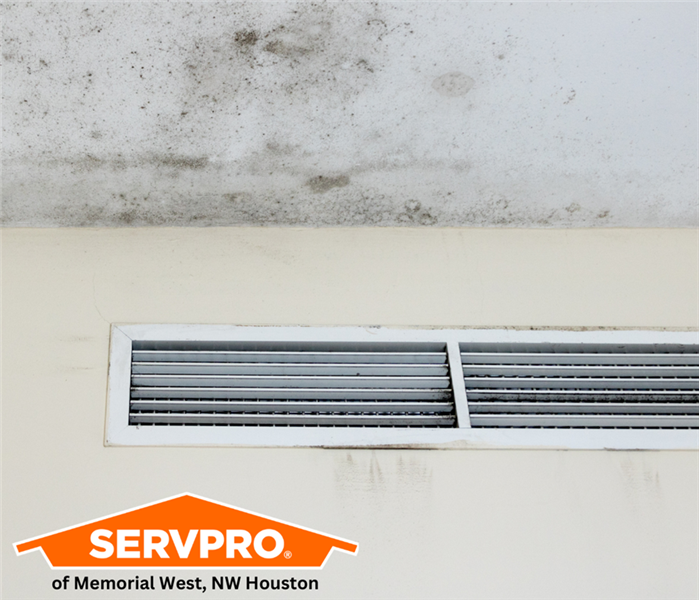 Microbial growth in a Houston, TX Home, how to prevent further spreading through out your home.
Microbial growth in a Houston, TX Home, how to prevent further spreading through out your home.
When water damage strikes, whether from a burst pipe, a leaky roof, or an unexpected flood, the immediate concern is often to stop the water and clean up. However, there’s another critical issue that can quietly develop in the aftermath: mold. At SERVPRO of Memorial West, NW Houston, we understand the hidden dangers mold poses and how crucial it is to address it swiftly to ensure a safe and healthy environment. In this blog, we’ll explore why mold is a serious concern, the risks it presents, and how you can protect your home. Protecting your home is priority to prevent further issues. The EPA offers a great guide on how to address signs of mold and further steps on how to prevent further spreading.
Why Mold is a Concern
After water damage, microbial growth can start appearing within 24 to 48 hours if the conditions are right. The longer moisture persists, the more mold can spread, potentially causing extensive damage and other problems.
1. Structural Damage
Mold can wreak havoc on the structure of your home. It can weaken wooden structures, damage drywall, and cause paint to peel and bubble. Over time, this can lead to costly repairs and potential safety hazards. Mold often grows in hidden areas such as behind walls, under floors, and in attics, making it difficult to detect without professional help.
2. Unpleasant Odors
Mold has a distinct, musty smell that can linger long after the visible mold has been removed. This odor can seep into fabrics, carpets, and furniture, making your home less pleasant to live in. Addressing mold quickly can help prevent these persistent odors.
How to Prevent and Address Mold Growth
1. Act Quickly
The key to preventing mold growth is to act quickly. If you experience water damage, start the cleanup process as soon as possible. Remove standing water, dry out affected areas, and ensure proper ventilation.
2. Professional Inspection
Sometimes mold is not visible, but it can still be present. A professional inspection by SERVPRO of Memorial West, NW Houston, can help identify hidden mold and assess the extent of the damage. Our experts use specialized equipment to detect moisture and mold growth in concealed areas.
3. Proper Remediation
If mold is detected, it’s essential to address it with a thorough remediation process. This involves removing contaminated materials, cleaning affected surfaces with specialized solutions, and ensuring the area is completely dried out. Simply cleaning visible mold is not enough; underlying issues must be resolved to prevent recurrence.
4. Prevention Tips
To prevent future mold growth, consider the following tips:
Mold is a hidden danger that can cause significant damage and other issues if not addressed promptly. At SERVPRO of Memorial West, NW Houston, we are committed to helping you prevent and tackle mold problems effectively. If you experience water damage or suspect mold growth, don’t hesitate to contact us for a professional inspection and remediation services. Protect your home by taking swift action against mold.
Is DYI Mold Removal Possible, Houston, Texas?
5/13/2024 (Permalink)
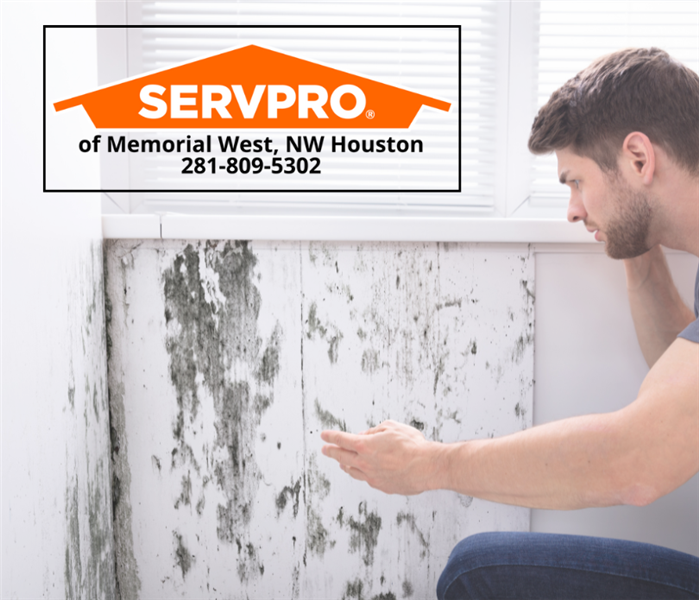 Best DYI ways to remove mold in your home or business in Houston, Texas
Best DYI ways to remove mold in your home or business in Houston, Texas
Is DIY Mold Removal Possiin Houston, Texas?
It has been a wet Spring here in Houston. When it’s wet, mold loves to grow and multiply. While the idea of tackling mold removal yourself may seem appealing, it's important to consider the potential risks and limitations involved. Mold infestations can escalate quickly, leading to further damage and health concerns if not addressed promptly and properly. Before trying to tackle a DIY mold removal project, it's crucial to weigh the pros and cons and understand when it's appropriate to seek professional assistance.
When to Consider DIY Mold Removal:
- Easy-to-Remove Mold: If the mold growth is minimal and easily removable, DIY removal may be feasible. Conducting a bleach test can help determine whether the mold is responsive to cleaning efforts.
- Limited Infestation: If the affected area is less than 10 square feet and confined to nonporous surfaces like glass, sinks, or tile, DIY removal may be manageable.
- No Health Concerns: If there are no vulnerable individuals in the household, such as children, elderly individuals, or immunocompromised individuals, DIY removal may be considered safer.
When to Seek Professional Help:
- Extensive Infestation: If the mold infestation exceeds 10 square feet or is widespread throughout the property, professional intervention is recommended.
- Uncertainty About Mold Type or Source: If you're unsure about the type of mold present, its source, or the extent of the infestation, consulting SERVPRO of Memorial West, NW Houston to assist with the mold remediation is advisable.
- Mold in HVAC Systems or Enclosed Areas: Mold growth in HVAC systems or within walls requires specialized expertise and equipment for thorough removal.
- Hidden Mold: Mold growth in concealed areas, such as behind walls or under flooring, may require professional inspection and remediation.
- Health Concerns: If you or your family members experience mold allergy symptoms or have respiratory conditions, professional mold remediation is essential to minimize health risks.
Preparing for DIY Mold Removal:
Before embarking on DIY mold removal, it's essential to take the following precautions:
- Conduct Research: Familiarize yourself with mold remediation guidelines provided by reputable sources such as the EPA and
- Identify Infested Areas: Thoroughly inspect your property to locate mold growth and identify potential sources of moisture.
- Wear Protective Gear: Equip yourself with appropriate protective gear, including an N-95 respirator, gloves, goggles, and disposable clothing.
- Use Effective Cleaning Products: Choose mold cleaning products that are effective for the type of mold and surface being treated, avoiding bleach for porous materials.
- Ensure Proper Ventilation: Maintain adequate ventilation during the removal process to minimize airborne mold spores.
DIY Mold Remediation Process:
Follow these steps for effective DIY mold removal:
- Seal Off the Area: Contain the affected area to prevent mold spores from spreading to other parts of the property.
- Clean Moldy Surfaces: Use appropriate cleaning products and scrub brushes to remove mold from surfaces.
- Dry and Seal Moldy Areas: Thoroughly dry cleaned surfaces and apply a sealant to prevent mold regrowth.
- Dispose of Contaminated Materials: Safely dispose of materials contaminated with mold, such as carpets or debris.
- Post-Cleaning Measures: Vacuum the area with a HEPA filter vacuum and address any lingering moisture issues to prevent mold recurrence.
When to Contact a Certified Mold Remediation Specialist like SERVPRO of Memorial West, NW Houston:
- Extensive Damage: If the mold infestation covers more than 10 square feet or extends beyond visible surfaces, professional intervention is necessary. Certified mold remediation specialists have the expertise and equipment to address large-scale mold problems effectively.
- Complex Situations: Mold growth in HVAC systems, enclosed spaces, or hidden areas like behind walls requires specialized knowledge and techniques for thorough removal. Certified professionals can conduct comprehensive inspections and implement targeted remediation strategies.
- Health Concerns: If you or your family members experience mold allergy symptoms, respiratory issues, or other health problems related to mold exposure, it's crucial to seek professional assistance. Certified mold remediation specialists can assess health risks, implement containment measures, and ensure safe removal practices to protect occupants' health.
- Uncertain Mold Type or Source: If you're unsure about the type of mold present, its source, or the extent of the infestation, consulting a certified mold remediation specialist is essential. They can conduct mold testing, identify underlying moisture issues, and develop tailored remediation plans based on professional assessment.
- Comprehensive Solutions: Certified mold remediation specialists like SERVPRO of Memorial West, NW Houston offer comprehensive solutions beyond surface cleaning. We address underlying moisture problems, implement preventive measures, and provide post-remediation testing to ensure the effectiveness of the remediation process.
Conclusion:
While DIY mold removal may be suitable for minor infestations under specific conditions, certain situations require the expertise of certified mold remediation specialists like SERVPRO of Memorial West, NW Houston. With specialized training, advanced equipment, and proven techniques, our certified team of specialist will safely and effectively address mold issues, ensuring the health and safety of occupants and the long-term integrity of the property.
Houston Mold Removal Services Provided by SERVPRO of Memorial West, NW Houston
4/15/2024 (Permalink)
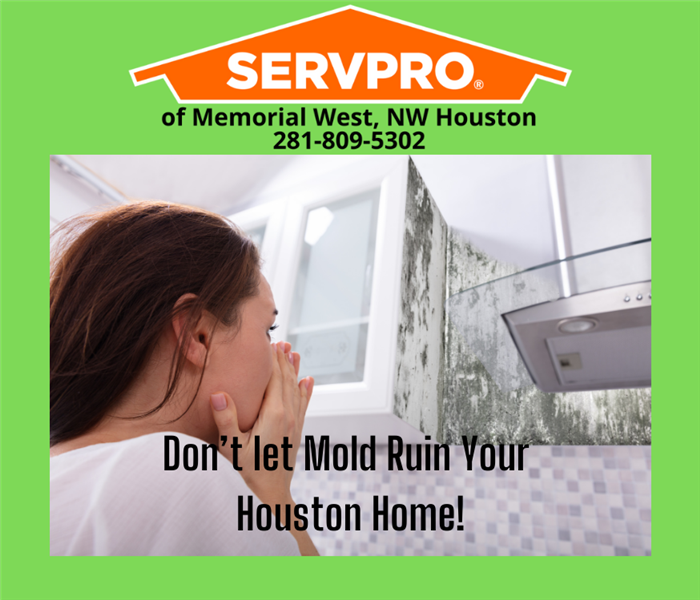 Don't let mold ruin your home, call SERVPRO of Memorial West, NW Houston. We will promptly send our team of IICRC technicians to your home.
Don't let mold ruin your home, call SERVPRO of Memorial West, NW Houston. We will promptly send our team of IICRC technicians to your home.
Discovering mold growth in your home or office can be alarming, but with SERVPRO of Memorial West, NW Houston's expertise, you can address the issue swiftly and effectively. Mold thrives in environments with moisture and warmth, often manifesting in areas like corners of rooms or on ceilings where water leaks or condensation occur. If you spot mold in your Houston property, don't hesitate to reach out to SERVPRO for assistance.
Our certified mold removal experts in Houston, SERVPRO of Memorial West, NW Houston, are equipped to handle mold remediation with precision and care.
https://www.SERVPROmemorialwestbearcreek.com/mold-remediation.
We understand the urgency of addressing mold growth promptly, as it can cause damage to surfaces and structural items, as well as produce unpleasant odors. With our rapid response time, we can be on-site within a hour of your call, ready to assess the situation and implement necessary measures.
At SERVPRO, our mold remediation process follows industry-approved protocols to ensure thorough and lasting results. This includes:
- Inspection and assessment of mold damage.
- Identification and correction of moisture sources to prevent mold recurrence.
- Implementation of containment protocols to prevent the spread of mold spores.
- Utilization of air filtration systems to remove contaminated air.
- Removal and proper disposal of mold-contaminated materials.
- Cleaning and sanitization of affected surfaces, including HVAC systems.
- Restoration and repair services to restore your property to its pre-mold condition.
In addition to remediation, SERVPRO offers solutions to help manage moisture sources and prevent future mold infestations. This may involve insulating pipes, repairing plumbing or window leaks, or installing dehumidifiers to regulate humidity levels.
When mold threatens your property, trust SERVPRO of Memorial West, NW Houston to provide comprehensive and effective remediation services. Our team of certified experts is dedicated to restoring your home or office to a clean and healthy environment. Don't let mold take hold – contact SERVPRO for swift and reliable assistance.




 24/7 Emergency Service
24/7 Emergency Service




